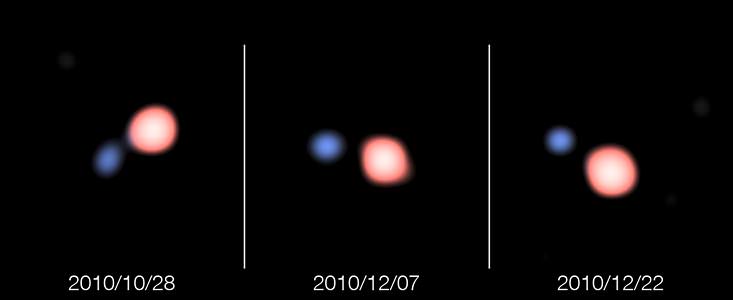[/caption]
How do you peer into the dark heart of a vampire star? Try combining four telescopes! At ESO’s Paranal Observatory they created a virtual telescope 130 metres across with vision 50 times sharper than the NASA/ESA Hubble Space Telescope and observed a very unusual event… the transfer of mass from one star to another. While you might assume this to be a violent action, it turns out that it’s a gradual drain. Apparently SS Leporis stands for “super slow”.
“We can now combine light from four VLT telescopes and create super-sharp images much more quickly than before,” says Nicolas Blind (IPAG, Grenoble, France), who is the lead author on the paper presenting the results, “The images are so sharp that we can not only watch the stars orbiting around each other, but also measure the size of the larger of the two stars.”
This stellar duo, cataloged as SS Leporis, are only separated by slightly more than one AU and have an orbital period of 260 days. Of the two, the more massive and cooler member expands to a size of about Mercury’s orbit. It’s this very action of being pushed closer that draws the hot companion to feed on its host – consuming almost half of its mass. Weird? You bet.
“We knew that this double star was unusual, and that material was flowing from one star to the other,” says co-author Henri Boffin, from ESO. “What we found, however, is that the way in which the mass transfer most likely took place is completely different from previous models of the process. The ‘bite’ of the vampire star is very gentle but highly effective.”
The technique of combining telescopes gives us an incredibly candid image – one which shows us the larger star isn’t quite as large as surmised. Rather than clarifying the picture, it complicates. Just how did a red giant lose matter to its companion? Researchers are guessing that rather than streaming material from one star to another, that stellar winds may have released mass – only to be collected by the companion vampire star.
“These observations have demonstrated the new snapshot imaging capability of the Very Large Telescope Interferometer. They pave the way for many further fascinating studies of interacting double stars,” concludes co-author Jean-Philippe Berger.
Where’s van Helsing when you need him?
Original Story Source: ESO Press Release For Further Reading: An Incisive Look At The Symbiotic Star SS Leoporis.


Wooha! 130m telescope (virtual or not)! I wonder what else this technique can be used to image… From what I read SS Leporis is located 1100ly away and we can image individual stars seperated by 1AU?! Über COOL 😀
yes, that is impressive.
The stars are at a distance of 279 ± 24 pc, where the method is optical interferometry. The slight difference at the two telescopes in the form of the optical wave front of light from the object is used to form the image. This is a variation of radio interferometry is radio astronomy. The relative closeness of the stars makes this technique applicable for an object of such small size.
LC